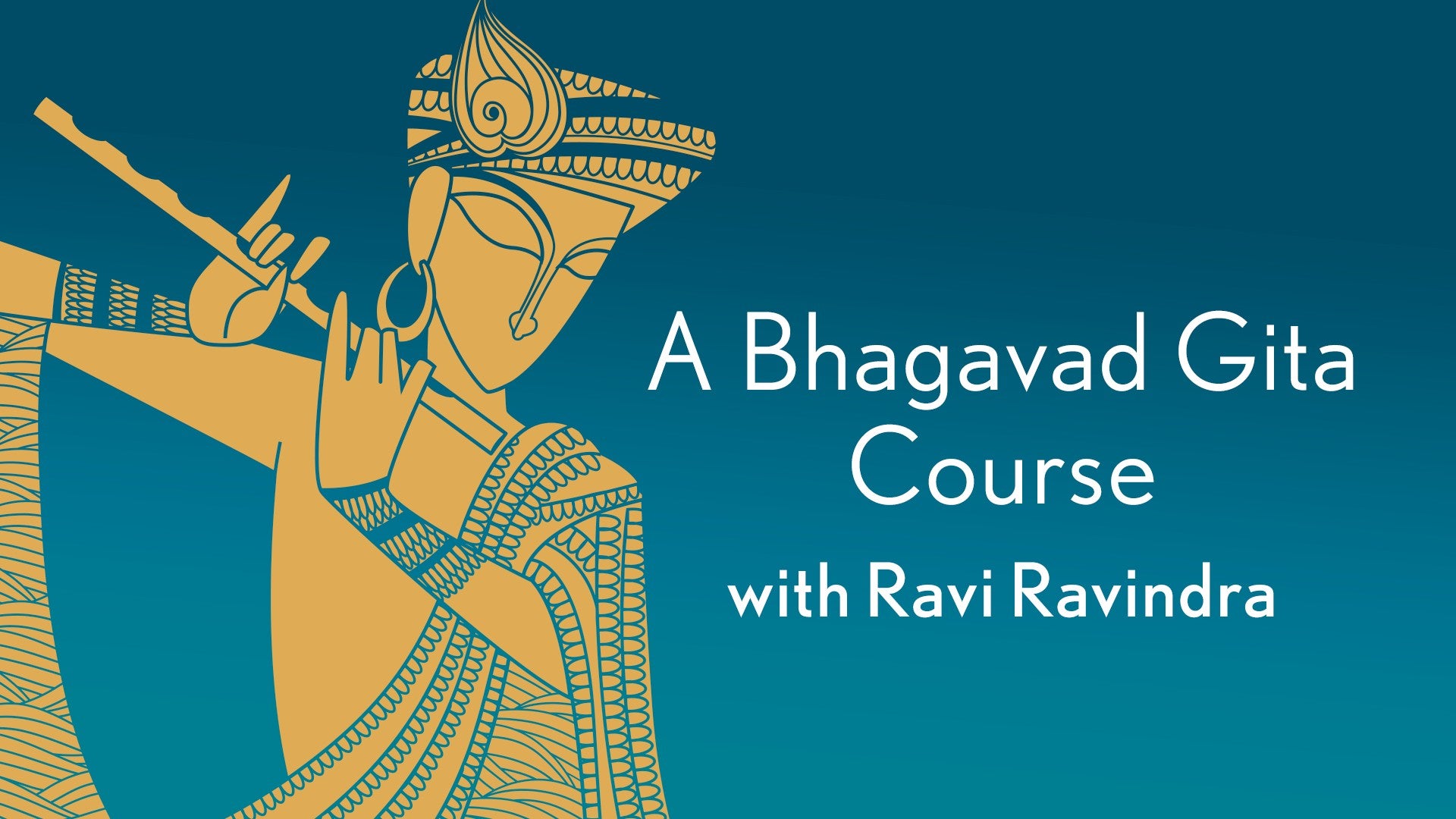Description
About This Video
Transcript
Read Full Transcript
Meditation
I have the impression that many of us are accustomed to meditation over a long period, so it's always good to come back to the fundamentals. Why do we meditate or really undertake any spiritual practice? Certainly according to all the great teachers throughout human history, the enunciation is that the entire space in the whole cosmos is filled with subtle and conscious energies. Certainly we would expect the labels to vary from culture to culture, language to language, whether it is filled with the Absolute or with God or with Brahma or the Holy Spirit. What is common to all of these labels, that these energies are subtle and more conscious than we are.And because they pervade the whole universe, therefore this room is also filled with this conscious energy. If you wish, just for convenience, we sometimes use one expression. So the Holy Spirit is right here. So the invitation is, can my energy, strength, power, talent actually become an instrument of this divine will, instrument of the Holy Spirit or of Krishna or of God, whatever label appeals to you. Since these forces are more conscious than we are, we cannot command them.
The suggestion is, how can we become more and more receptive so that I am not merely touched by the Holy Spirit, that I begin to be more and more able to hear subtle whispers. And the fundamental contribution from our side is relaxation, subtler the energy more easily it is repelled by tensions. So take a few moments to be aware whether I am now able to be sitting here, whatever posture, and am I as relaxed as I can now manage to be. Much more than physical relaxation, what is really important is emotional relaxation. Any kind of emotional tension such as anxiety, worry, resentment, even expectation, and of course not to speak of really large tensions like anger, even the milder ones, these emotional tensions repel subtle energies.
So we take a few moments to see if I can be emotionally relaxed. Not worrying about this or that, at least for a few minutes. And if I can remind myself without knowing any exact data that the universe is very large, trillions of galaxies, and that in this large universe I should be created for a few decades. That simple reminder for most of us produces a feeling of gratitude. Even a sense of wonder, recalling the largeness of the universe, one wonders why should I be created for a few decades.
Always a helpful reminder that I did not create myself or this breathing apparatus nor the air that I need to breathe to be alive, even for a few minutes. Then in addition to the sense of gratitude, a sense of wonder comes. And these two feelings are subtler than any of our usual worries and anxieties. And they take up this energy, emotional energy, more towards relaxation. In fact, I often remind my friends that a sense of wonder and anxiety cannot coexist.
So to keep returning to this great miracle that I exist, and only for a few decades. The other contribution from our side is to find the right alignment. When initially we begin physically, the physical posture, our contemporary biologists tell us that the only creatures who can have a vertical posture, and if their eyes are open they can look horizontally, are human beings. No other creature has this possibility. And if it is true, as all the sages have said, that the universe is created by the highest level of consciousness, this special possibility for human beings is very likely a particular call to us.
So to find a posture, a vertical posture without rigidity, and if my eyes are open I should be able to look horizontally. But in addition to physical postures, we also have intellectual postures. Everything I hear, there is a tendency to make a comment on it. Maybe I like it or I don't like it, or whether it agrees with the Bhagavad Gita or the Bible or with Plato or whatever. That implies as if I am able to make a comment on everything I hear.
If I can remind myself of the obvious fact that even if I had the combined intelligence of the greatest scientists and philosophers, I still cannot know all there is to know. Or to keep coming back to a state of unknowing, I am open to hear something that may surprise me. State of unknowing, not a state of ignorance, but a state of being open to knowing something that I do not now know. These are the two major contributions from our side to be able to become receptive, but also actively receptive, discerningly receptive. A reminder that this room as well as the entire space according to all the sages without exception, also all the great scientists, for example, Einstein called, it's filled with cosmic intelligence.
We take a few moments now simply sitting here finding the right posture, willing to be surprised, feeling relaxed. And to assist the ordinary mind from wandering away and to stay here, I become aware of the fact that breathing is taking place. And I can become aware of the movement of my abdomen, up and down, corresponding to breathing in and breathing out. And I can become aware of the movement of my abdomen, corresponding to breathing out. We'll return to this practice and develop it further in our next lesson, but right now we just take three more breaths and then we'll stop.
Thank you.
Talk
Welcome to day one of the course on the Bhagavad Gita, which is a classical text of yoga, varieties of yoga in it. So we will speak about them in due course. Let me begin first of all by just simply reminding you that the Bhagavad Gita is a highly regarded text not only in India, but any great scholars and searchers outside India as well. But just to place it in its background of the Indian tradition, I will begin with a few remarks, in fact, actually coming from the Rig Veda, which is the most ancient text in any Indo-European language.And in India, this would be regarded as really very much the beginning of the whole Hindu tradition. The Bhagavad Gita, in a way, very much carries some of the very fundamental ideas arising from the Rig Veda. But just like any great writer, they use the language which is there. But after the great writer, the language slightly shifts. Similarly, the Bhagavad Gita slightly shifts some of the very basic ideas.
So let me begin, first of all, by reminding something from the Rig Veda. And just as an honor to the ancient language, I will actually say that in Sanskrit, Navijanami Veda Masmi, Ninyasandha Manasacharami, I do not know whether I am the same as this cosmos, a mystery I am, yet burdened by my mind I wonder. Sometimes it is translated, yet conceited in my mind I wonder. So we can think of all our scientists and philosophers, including ourselves, who are very much occupied with our minds, and we imagine we know what we are doing. So on the other hand, the question really raised as far back as we can recall about two fundamental realities.
In Sanskrit, the two words are aham and idham. Aham simply means myself, and idham really referring to the whole cosmos. What is the relationship between these two mysteries? Are they completely independent? Are they arising from the same source?
And the completely, repeatedly, throughout Indian tradition, in fact throughout all the spiritual teachings, the emphasis is that everything, whether we call living or not living, external cosmos, internal nature, myself, universe, everything comes from that one. The first Sanskrit expression is tad ekam, that one. And in the Indian context, the word that gets used for that one is brahma, literally means the vastness or the largeness or the endlessness, but contemporary English word vastness does not seem to contain time, so sometimes one would translate this as the eternal, to also include the infinity of time. And by its very nature, it is referred to as it rather than he or she, simply because we have a tendency in modern languages that until somebody's little bit developed in gender, we refer to it as mutagenter. In this particular context, brahma is not degenerated enough to have a gender, it is above gender, it is beyond gender, therefore the reference is it.
Its genderification comes only in the manifested universe, whereas brahma is both in the manifested universe as well as beyond the manifested universe, so no gender is attached to it. Then what is very important, and it is actually a very deeply different attitude from the whole of the Abrahamic tradition, I don't have time to go into this, but this particular idea, let me just mention it, in India there is not strictly speaking a creation myth that God created the universe, and in the Abrahamic tradition, no creature can possibly come to become the same as the creator. In fact, this is the greatest blasphemy, and when Christ said, my father and I are one, he was charged with heresy. In India, on the other hand, there is not a creation myth, but we might say an emanation myth, brahma did not create the world, brahma became the world. So brahma is in everything, it is everything, even the cockroaches have brahma in it.
It's important to understand this great difference, and therefore from the perspective of the Indian tradition, and anybody interested in yoga needs to understand this, what is yoga aiming at, or what any teaching is aiming at in India, is to discover one's own brahma nature, to discover I am God. You can see how we'll be in trouble everywhere else. So it's important to therefore understand a very radical difference in the two major spiritual traditions, and just for simplicity, Abrahamic tradition includes whatever we mean by Judaism, Christianity, Islam, and Indian tradition includes whatever we understand by Hinduism, Buddhism, Jainism, Sikhism. There are naturally many differences within each of these traditions, but that will take a long time to go into great detail. But in general, these two major spiritual traditions have many things in common, obviously.
For example, that the whole universe is created from the highest level of consciousness, which is completely contrary to our modern scientific perspective, where everything is created from matter, from the lowest level of consciousness. So there are many things which are common. However, this is a very fundamental difference, and it is therefore important to be aware of this. So same thing is repeated in every teaching in India later on, or by every great teacher in India. For example, Raman Maharishi in the 20th century, or Aurobindo, or Krishna Murthy, or in the 19th century, Ramakrishna, throughout history, great sages in India have repeated this idea in one form or the other.
So for example, Krishna actually says in the Bhagavad Gita, this is in the 13th chapter. Everything is born from the union of the field and the knower of the field. I am the knower of the field in every field. So Krishna is there in everything, even in my toenails, Krishna is there. This is a very important thing to understand, whether one agrees with it or not, but when it is important to understand what is being said by the tradition.
And therefore, very much the suggestion that absolutely everything has some level of consciousness, naturally manifesting at different levels of consciousness and correspondingly different levels of materiality. So it's not that there are no differences in consciousness, but still everything has some consciousness. So this will be for this highest reality, very standard kind of expressions that get used. For example, satyam, ritam, brahat, truth, order, vastness, or light, eternal love, or truth, consciousness, and delight, or truth, love, and beauty. These will be the standard sorts of expressions which are used to describe the highest level of reality, even though all the sages keep saying that it can't be described.
This is a very fundamental idea, actually in the Upanishad, the expression which is used is neti neti, not this, not this. Nevertheless, having said that, still something gets said, that is, towards more and more truth, more and more love, more and more beauty, that's the general direction. More awareness, more sense of service, those are the general directions. So not to get too attached to one particular thing, because then we have our own idea of what is love, or what is beauty. Think of this more or less as a vector pointing towards something rather than as a fixed position.
So in the vastness of the universe, if we can just remind ourselves again and again, trillions of galaxies, and many different levels of consciousness, and a very fundamental idea that the very word spiritual, referring to spiritual domain, is subtler than the body and the mind. Therefore the mind cannot quite figure it out. Which is why the very first substantial sutra in the Yoga Sutra, as you know, is the second sutra in the first chapter, Yoga Chitta Vritti Nirodha, Yoga is stopping all the movements of the mind. Because until the ordinary mind is quieted, we are not able to relate with the reality which is subtler than the mind. Every spiritual practice wishes to move towards that.
And on the other hand, one should also remember that within the realm of the spiritual world, there are many levels. For example, most of you would know, in the Bible there are nine orders of angels. They are all spiritual. And at different levels, there are different laws that apply. An angel can go through this wall, I cannot.
An archangel can be at two places at once. One cannot. So it's important to understand that there are different laws that apply at different levels of consciousness, if you like, or different levels of spirituality, or different levels of nearness to God. Then in the light of it, naturally the question obviously arises. This large universe full of cosmic intelligence, why am I here?
Or who am I? This, in the Indian tradition, the Sanskrit word is koham, literally means who am I? Sometimes personally I prefer the translation, what am I? Is regarded as the Bij Prashna, as the fundamental question. And this is there for every spiritual teaching, at least in India, they come back to this again and again and again.
And of course the call is towards discovering that ultimately I am Brahma. Now of course in every teaching, not only in India, the ultimate is said to be inexpressible, but in India also it is inexpressible. What does it mean? That the mind cannot capture it, but one can embody it. It is wholly other, but intimately myself.
This is radical difference from the Abrahamic tradition. But I should here remind you that even in the Abrahamic tradition, all the great sages and scientists, Christ is a very good example, Rumi is a very good example in Islamic tradition, they in fact say exactly this, it's just that the churches don't like to propagate this, that's a different pattern. But the call, after all, I don't want to get into all those details, but these gospels become non-canonical. For example, the Gospel of Philip, I am quoting, Christ came not to make us Christians, but to make us Christ. This is absolutely standard idea in India.
The Buddha said, look within, you are the Buddha. Raman Maharishi, contemporary, 20th century, great sage, I am Brahma. This is exactly what actually all the sages, even in the Abrahamic tradition, actually say and experience, but the churches don't like to say that. So it becomes, therefore, a radical or something, they have to be condemned or crucified or something has to be done. So we return, nevertheless.
It's a very standard idea, the oldest Upanishad actually has this very expression, I am Brahma. Why the Bhagavad Gita? First of all, all this background that I have just given, all of this we would find in the Bhagavad Gita. But naturally, as I said earlier also, slight shift in language, then post-Bhagavad Gita is much more influenced by the Bhagavad Gita than by the Rig Veda, interestingly. But just like post-Shakespeare, English is much more influenced by Shakespeare.
People may not believe it, although he is obviously using English, which also existed before Shakespeare existed. So Bhagavad Gita is certainly, at least in my understanding, is the one single most important text to emerge from India. And it deals with all aspects of the life of a person, love, action, prayer, meditation, knowledge, any aspect. It deals with it, which is actually not true for any other scriptural text in India. And then I have a couple of quotations here from the outsiders speaking about India, or the Bhagavad Gita.
But before that, I have one remark here from the Bhagavad Gita, simply to say again what I earlier said about wishing to be Brahma. This is what Bhagavad Gita in Chapter 4 says, delivered from attachment, fear and anger, mindful of me, this is Krishna speaking, taking refuge in me, having been purified by the fire of sacred knowledge, many have attained my state of being, Madhabaav. This is the aim. The aim is not to be anything other than the level of Krishna, other than Krishna reveals himself as the incarnation of the highest divinity. So that is the core, which is also, by the way, the reason why in some places yoga is banned because, strictly speaking, that is the aim of yoga, to find one's Brahma nature.
For example, in Malaysia, it's a majority Muslim country, yoga is actually banned because this is against the whole Abrahamic tradition. And occasionally cases like this arise even in California, actually, or in the USA. So one needs to understand, but don't be in any hurry, even the Buddha took many lifetimes. So we are not going to get there in this lifetime easily. But let me continue with just two remarks from people outside India who remark on the Bhagavad Gita.
One is the American author Henry David Thoreau. Here I'm just reading it aloud. In the morning I bathed my intellect in this stupendous and cosmogonal philosophy of the Bhagavad Gita. It's whose composition the ears of the gods have elapsed, and in comparison with which our modern world and its literature seem puny and trivial. And I doubt if that philosophy is not to be referred to a previous state of existence so remote in its sublimity from our conceptions.
This is Thoreau. In fact, I don't have that remark right here, but he also later on said, if I was stuck on an island and could take only one book with me, it'll be the Bhagavad Gita he'd like to take with him. This is a remark of Aldous Huxley, who wrote that very famous book called the Perennial Philosophy. And this is what he said, the Bhagavad Gita is one of the most clear and comprehensive summaries of perennial philosophy ever revealed. Hence its enduring value is subject not only to India, but to all of humanity.
Naturally, the dating of this text varies. In India, there has not been very much emphasis traditionally on history, a little bit like our contemporary scientists. Most physicists are not very interested in history of physics. If a law is true, it is true. It doesn't matter whether this was set 2,000 years ago or 20,000 years ago or 100 years ago.
So there is a very different attitude or whether it was set in India or set outside. So there is not very much emphasis on the historical aspects in India generally. And they would simply say, oh, the Bhagavad Gita, there is four major stages in the development of a single cycle of the universe before the whole universe dissolves and starts again. And it takes billions of years in the Indian cosmology. So for them, it's really a shift from Dwapara Yoga to Kali Yoga, two of the stages in the universal cycle.
But most Western philosophers are naturally, they are interested in history and they wonder. So the dating of it, according to mostly the Western authors, is anywhere between 500 BCE to approximately 300 BCE. However, I was rather struck by a remark of Juan Mascaro, who also translated the Bhagavad Gita. Actually, the Penguin edition of the Bhagavad Gita is translated by him. And he made this very interesting remark.
I'm simply reading this from his introduction. Scholars differ as to the date of the Bhagavad Gita. But as the roots of this great poem are in eternity, the dates of its revelation in time is of little spiritual importance. I think that's rather a nice way of saying, sure, we can keep arguing about it. And you can be sure.
Not all scholars have to make a living. If they agree, then what are they going to do? So they have to disagree and prove something or the other. Then the other scholars will come back and say, this will go on. So let me then begin with the just general background of the Bhagavad Gita.
It's one of the books in the very large epic called the Mahabharata. In fact, a great Dutch scholar after trying to translate the Mahabharata came to the conclusion, and I'm quoting him, saying, it's not a text, it's a library, it's a very large text. In any case, a battle has become inevitable in spite of the fact that people, wise people on both sides, try to stop the battle, but the battle essentially is arising for the usual human reasons, greed, for power, or for wealth, or taking revenge. Somebody has insulted me, even in a previous life. In India, that is just taken for granted, that there are many incarnations.
And so then occasionally somebody out of loyalty, because they have been serving a king, so even if they are convinced, in fact, two quite wise people, you don't need to worry about their names, Bhishma and Drona, both of them are very wise, and they are more or less even aware of the real nature of Krishna, which very few people know. This itself should not be surprising, even the Mother of Christ was not aware of His real nature. And John the Baptist, whose whole mission was to announce the coming of Christ, when Christ comes towards Him, He doesn't recognize Him. So this is not surprising, because really the fundamental idea is, until I know my own real nature, I cannot know the real nature of anybody else. And so Krishna gradually reveals Himself to Arjuna after His gradual transformation, Krishna's real nature in the Bhagavad Gita, which is that He is an incarnation of the highest divinity.
But very few people know this. So when the battle has become inevitable, so both sides are basically trying to ask all the neighboring kings for help in the battle. And Krishna is regarded as one of the minor kings in a little minor kingdom. So both sides go there. So let me just mention two names here.
One is Arjuna, whose name is good to mention, because the whole Bhagavad Gita is essentially a dialogue between Arjuna and Krishna. The other name is not so important to mention, but Duryodhana, who is representing the other side. And he is very much hungry for power, for controlling the whole thing. And so the two of them, Arjuna and Duryodhana, representing the two sides, go to Krishna as a king in a minor kingdom to ask for His help. Now I should make one general remark here.
In India, even in any mythological versions, or historically even, for example, the battle in the Bhagavad Gita, it is never wholly between totally good people and totally evil people. Because in India, there is no conviction, unlike in the Abrahamic tradition, especially in Christianity, the idea that after the second coming of Christ, the evil will completely disappear and it will be all good. In India, the whole idea is that the manifested universe cannot exist without both sides, negative, positive. So that will never happen, as long as the universe exists. Therefore specifically in any of the mythological stories even, for example, in the Mahabharata, although these two sides are fighting with each other, but let me assure you there is no conviction that one side is wholly bad and the other side is wholly good.
Just as a very quick reminder, Krishna's older brother himself refused to fight because he was convinced that the other side actually had the legal right to the throne. But because his brother was on one side with Krishna, with Arjuna, therefore he was the only warrior it is said, whether this is history or mythology, don't worry about this, that he was the only major warrior who actually did not engage in the battle for the simple reason that he was convinced the other side is correct or closer to the throne, but because his own brother is with Arjuna on the other side, so he would not fight. So I'm just reminding you this, don't be convinced that one side is wholly good here, that the other side is wholly bad. No mythological story in India is like that. In any case, so both Duryodhana and Arjuna go to Krishna and Krishna gives them this choice.
One side can have all his armies with all their chariots, elephants, horses and weapons. The other side can have him alone. And furthermore, in this particular battle, Krishna says he will not pick up any weapons. It's not that he's unused to weapons, but in this battle he will not pick up any weapons. Now my own impression is that any reasonable person would choose, what would you choose?
Choose to me all the armies and the elephants and the weapons and the horses. There are two different versions of it. One is that Arjuna had the first choice and he chose Krishna. The other version is that he had the second choice and he was stuck with Krishna. But in either case, Duryodhana had all the weapons and the armies and Arjuna has Krishna.
And then now what is Krishna going to do? Just hang around. So Krishna becomes the charioteer of Arjuna, not taking up weapons. So Arjuna then asks Krishna to take his chariot in the middle of the two armies so he can survey who he has to fight. So then we have very, as you can well imagine, the artists in India absolutely go to town trying to paint various battle scenes, et cetera, et cetera.
Actually from a sculptural point of view, the largest sculpture I have seen is actually in Jakarta in Indonesia and a whole large sculpture, oh my goodness, practically I would say at least 300 meters, nearly 1,000 feet actually, very long. But in India, practically so much of the architecture or particularly sculpture and painting is dedicated to these very themes. Now here there are two or three remarks I need to make. First of all, according to all the sages in India who have made any remarks about the Bhagavad Gita, this is not an external battle. It is actually a battle within ourselves.
Secondly, Arjuna and Krishna are not outside. They are representing different levels of ourselves. Arjuna representing the deepest level and Arjuna representing our usual level. Couple of things that need to be said here. First of all, just words.
These are the only two names. Every name has a meaning. This is actually true in the Bible as well. People often don't realize this. Every name has a specific meaning.
So whether these characters historically existed or not doesn't matter, but from the point of view of the authors, they may take an external war and then read a whole philosophy behind this or a whole teaching behind this. Krishna literally means dark and Arjuna means pale or white. If we look at the ocean, the surface is relatively speaking clear, the depth is not clear. This metaphor itself is a little different from the way it usually gets in the biblical traditions where white seems to represent the good and dark seems to represent the bad. In India, the suggestion is that all growth actually takes place in the dark.
If you take a plant out of the earth, you're going to kill it. You need to let it be in the dark to develop, to grow. So Krishna is referring to the mysterious, the unknown, something that is in the depth. And Arjuna is, as I said, literally the word means pale or white. There is another root of the word Krishna, that is Karshati, which literally means that what attracts you, what is the deepest attraction for you, that is your Krishna.
So that's another root of the word. Here one other remark I need to make, Arjuna is a very skillful warrior. In fact, even his opponents, when they wish to admire a warrior, they say, who is as great as Arjuna. And even now we have a government of India award called Arjuna Award. So this is very much a part of the culture.
So Arjuna is a very highly regarded, skillful warrior. This is important to understand because later on he has a crisis and he gives up his bow and arrow, not because of cowardice, but because of a whole crisis of conscience. I will come to that in a moment. So the other thing to then keep in mind, that transmission of culture actually takes place starting with young children, through fairytales, through myths, through art, through music. And increasingly there is an enormous amount of scientific data gathered now that if one grows up listening to Chinese music rather than European music, your whole structure of the brain is altered.
And so the culture is actually transmitted from children. Later on more philosophizing can take place, but emotional language is learned within the first three or four years. By emotional language I mean the same words have a different meaning emotionally. And therefore it becomes necessary for transmission of culture that internal, subtle experiences or understanding has to be externalized. I myself now have, actually now she is five and a half years old granddaughter, for me to say to her that the Bhagavad Gita is really a dialogue between my deepest self and my selfish self can have no meaning.
So it's a dialogue between Krishna and Arjuna. Krishna stood here, Arjuna stood here, this is what Arjuna looks like, this is what Krishna looks like, this is exactly the manger in which Christ was born. Why? Just to remind you quickly that the actual spiritual practice is in the opposite direction. Just a very quick reminder, Saint Paul who is hardly shy of traveling, hardly shy of writing, more than a third of the whole New Testament are writings of Saint Paul.
If any of you can show me anywhere where he says I went and visited the place where the Lord was born or where he was crucified, I will give you a ticket to fly to Halifax to meet me there. You see, this is not the interest. You look at any of the mystics or any of the sages in Christianity or anywhere else. The search is from outside inward, but the fundamentalists get occupied with what has been externalized. This is no fundamentalist in the world anywhere has ever produced a great sage.
You can just look at the history of Christianity as an example. A sage almost by definition proceeds from the outside inward. Simply to make a point here, I say that, Angelo Silesius, a 17th century great church, Dutch Christian mystic, this is what he said. Christ could be born a thousand times in Galilee, all in vain, unless he's born in me. That is the real search.
But externalization is necessary for transmission of culture. So we don't need to be against this. This is why all these fancy paintings of Krishna and Arjuna and all these sculptures, and also it is the requirement of the arts. Then on the other hand, I'm sure you can say this from your own experience, sometimes we look at a work of art and if it is really great, we say, isn't that amazing? Starting from the visible, somehow the artist manages to hint at the invisible.
That is what makes it a great work of art. Keeping this in mind, don't be against externalization. It is easier to speak, easier to paint, easier to sculpt, but it is not the direction for actual search. That's the important thing that's keeping in mind. Now, then another thing that is relevant here for me to say, that once a major metaphor is chosen, that also had its own logic.
For example, one could describe the journey of his soul as climbing a mountain. Actually Teresa of Avila, this is what she uses, a seven storied mountain. Or one could describe this as crossing an ocean. But if I choose crossing the ocean as the big metaphor, then big axes don't make any sense. If I choose mountain climbing as the big metaphor, then paddles don't make any sense.
So this is important to actually understand that here, the metaphor that has been chosen is of a battle. So the whole first chapter in the Bhagavad Gita is essentially just describing the battle, who has what kind of chariot, or what kind of bugles, or what kind of bow and arrow, etc. But it is extremely important to bear in mind that the metaphor has its own logic, but that is not the point of the teaching. For example, the same teaching will apply to a writer who has, let us say, a writer's block. And I can assure you, this is not uncommon.
He has written one book after that, especially if it becomes successful, then it is very difficult for them to write the second book, because it's not going to match the same thing. And so they have a writer's block. So then, if Krishna was approached by this character, so the Bhagavad Gita will be describing maybe a study or a library, rather than weapons it will have books. So Krishna would, rather than saying, therefore fight, he would say, therefore write. Nothing else will change.
Most of the Bhagavad Gita will be exactly the same. It's only the first chapter, which was largely changed. And then occasionally he does say, therefore fight. That will also change to, therefore struggle, therefore write. In fact, the same word is used, the Sanskrit word is yudha, which is usually translated as fighting or battle, but it also means struggle.
So therefore struggle. In fact, this is one of my favorite shlokas from the Bhagavad Gita, renouncing all your actions to me, Krishna says, mindful of your deepest self without expectation, without self-occupation, struggle without agitation. This is one of the very standard, same expression yudha is used there. So let me then turn here to reminding us that, of course, the requirement of the arts and transmission of culture. So you'll see very, very remarkable paintings and sculptures throughout Indian history of Krishna and Arjuna and the various chariots, sometimes three horses, sometimes seven, sometimes many more horses.
It goes on, it just depends on what the artist really can get away with practically. So then the way the story begins, if you like, that Krishna brings the chariot of Arjuna in the middle of the two armies, and Arjuna looks at the people he has to fight, and among those people are his own teachers, his uncles, cousins, nephews, and he has a crisis of conscience. It clearly does not match the kind of people he should be killing, he should be fighting. So this is how the Bhagavad Gita actually, the first chapter, in fact, it continues into the second chapter, the Bhagavad Gita, more or less, begins from there by Arjuna saying that even if they kill me, I will not fight. So he gives up his bow and arrow, but then he appeals to Krishna saying, here, I quote this from the Bhagavad Gita, this is the seventh shloka in the second chapter, my very being is afflicted with the flaw of pity and weakness of spirit.
My mind is bewildered about dharma. This is a very crucial word, and I will come back to this again and again. Here we could even say, my mind is bewildered about what is the right action. I ask you, he says to Krishna, tell me decisively which is better. I am your pupil for I have taken refuge in you, teach me.
Homework
This is how the teaching actually begins. And there I will stop today and to suggest a couple of exercises for you, if you wish. Because according to all the sages in India, as I said, this is actually an internal dialogue and internal battle. So if I wish to approach towards Arjuna, not that necessarily I have Arjuna in me, but moving towards Arjuna, reflect on the question yourself, what am I skillful at? Because Krishna was a very skillful warrior, and what purpose does my skill serve?And then you can write down in response in your journal, and that is towards your Arjuna. And then towards your Krishna, reflect on the question, what or who do I turn to for guidance when I am bewildered about a serious issue in my life? Which one of us occasionally has a great crisis, who do we turn to? Do I, could be, I go to a priest, or I sit down in meditation, or I go for a walk in the woods, whatever, whatever direction I move to, or person I move to, but that person is ultimately within you. Even if a priest says something, the question is, where does it resonate in me?
So that is towards your Krishna. So those are the two simple exercises, if you like, and we will now stop and have another course in the next day. Thank you so much.
Bhagavad Gita
Comments
You need to be a subscriber to post a comment.
Please Log In or Create an Account to start your free trial.





















